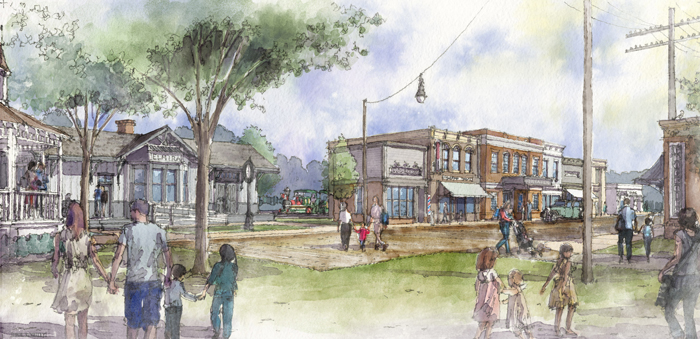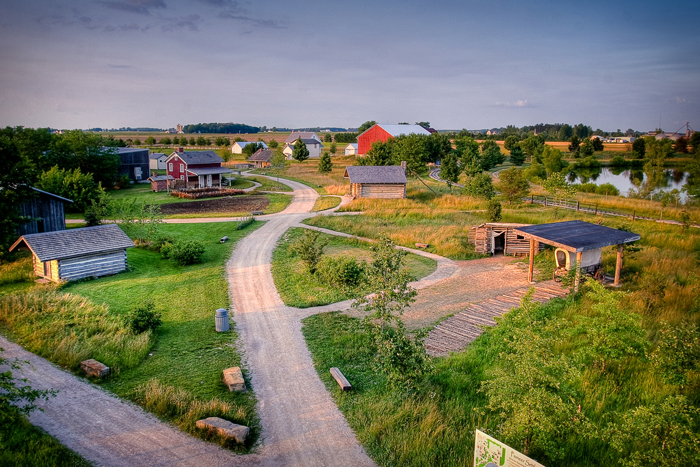As published in Toledo Business Journal - February 1, 2018

Rendering of Sauder Village’s 1920s Main Street Project
Sauder Village breaks ground on 1920s Main Street project
Sauder Village, a non-profit family vacation destination in Archbold, broke ground on the first phase of its $1.5 million 1920s Main Street Project. The project is the next phase of its Walk Through Time Experience, and is expected to be complete in the summer. The project will allow Sauder Village to replicate a portion of a 1920s Main Street typical of northwest Ohio.
Tim Bockbrader of EDGE’s Toledo office is performing the site planning and project design; the project architect is Paul Sullivan of Paul R. Sullivan Jr. AIA LLC; and Sauder Village is self-contracting the project, with Steve Sauder, director of facilities, supervising construction. Local contractors are being used for this project including Armstrong Excavating Inc., based in Fayette, Ohio and Wyse Electric based in Archbold. The Main Street road will be constructed with the necessary water, gas, sewer, and electric lines in place for the expansion project.
Debbie David, president and CEO of Sauder Village, said, “The Walk Through Time Experience at Sauder Village has been developed over the past 15 years with the help of staff, volunteers, contractors, donors, and capital funding. Guests can experience more than 120 years of Great Black Swamp history while travelling from Natives and Newcomers to Pioneer Settlement, the Grime Homestead, and soon the 1920s Main Street Community.
“Many people view the 1920s as ‘the new era’ in United States history. Often referred to as the ‘Roaring Twenties,’ this decade was a period of transition from America’s past to a more modern age. From advancements in transportation, communication, and technology to changes in the economy and social pastimes, there are many unique stories to be shared about life in the 1920s in northwest Ohio. Nearly six years ago we began working with members of our academic advisory committee on the 1920s phase of our master plan at Sauder Village.
“As we started to do research, a number of themes emerged regarding the importance of the 1920s – the ‘beginning of the modern age.’ Dramatic social and political change was a hallmark theme of the 1920s. With cities and towns offering varied employment opportunities, for the first time more Americans lived in cities than on farms. The economic system of the country was changing as people became part of a more consumer society. Political divisions arose between urban and rural communities, women secured the right to vote, and with the ratification of the 18th Amendment, Prohibition curtailed some American freedoms. Many of the themes of the 1920s still exist today, and in this next phase of our ‘Walk Through Time’ we will help our guests understand these themes through the personal stories and historic artifacts from that time period.”
There will be special programming planned as part of the 1920s Main Street Project According to David, history will be brought to life in this area with unique hands-on activities, stories, and demonstrations. There will also be opportunity to offer after-hours programs, musical performances, and other special events yet to be planned.

The Pioneer Settlement at Sauder Village
The plan also involves the relocation and building of new structures. According to David, these include:
- Elmira Train Depot – The impact of the railroad on rural daily life was significant in the 1920s, bringing rural communities in contact with the world through travel, commerce, and communication. The next phase of the Main Street project will involve relocating and opening the Elmira Depot. The Elmira Depot was originally located just two miles north of Sauder Village along an extension of the Wabash Railroad. The depot will serve as a physical stop for the Erie Express Train to transport guests throughout the entire historic timeline. The building includes a waiting room for passengers, an office for the stationmaster, and a freight room for storage, and it will also feature a telegraphy collection to share these vital communication tools used by the railroads
- Community Plaza and Bandstand – A community plaza and bandstand will be constructed near the depot to accommodate events and special programs. Original bricks used to pave the streets in downtown Archbold in 1897 and salvaged during a reconstruction project in 2005 will be used to create the plaza area near the depot.
- Barbershop – Businesses that catered to train passengers, like the barbershop, were some of the first to locate near the train depot. The barbershop was not only a place to spruce up from your travels or to have your hair cut; it was also a hub of communications in a small town. Locals and visitors alike could stop by and find out what was happening with others in the area and across the country. As part of the Main Street Project, a new barbershop will be constructed and will include the complete collection of artifacts from the Oakley Barbershop in Continental, Ohio.
- Livery – Finally, a livery will be built to tell even more about changes in transportation in the 1920s. The livery was another essential business, serving as a “parking garage and gas station” for farmer’s horses when coming into town. It also provided a place to rent a buggy and had a blacksmith for necessary repair work and horseshoeing. While many families still used horses for transportation in the 1920s, a growing trend in affordable motorized vehicles would change the need for the traditional livery business within the decade.
When speaking of the benefits of this project, David said, “Just in the state and region alone, more than 80,000 guests experience the Historic Village each season from across the country, including 18,000 school students who participate in educational experiences from throughout the tri-state region. Nowhere else in the nation is the 1920s story being told in a living-history setting, giving this project state and national significance. Guests will experience the ‘everyman’ stories of immigration, community building, technology advancement, and the creativity and entrepreneurial spirit of our ancestors. This expansion will benefit guests by demonstrating how society had to adapt as modern technologies influenced their lives in the 1920s, which mirrors the economic events experienced in the 1990s and 2000s. Nationally, Sauder Village annually attracts nearly 300,000 visitors to the complex including lodging guests who come from throughout the region and across the country. We anticipate welcoming even more people to Sauder Village with this new expansion to the Walk Through Time.”
According to David, Sauder Village is still seeking artifacts and continuing its fundraising efforts for the capital campaign for this first phase of the 1920s Main Street Project. It’s starting to receive leads on architectural remnants like a downtown building in Findlay, a storefront in Napoleon, Schucks Jeweler in Bryan, store fixtures, Oakley Barbershop artifacts, and more. Sauder Village is continuing to look for historic buildings and artifacts that include both exterior and interior lighting, woodwork, doors, and fixtures. Interior artifacts like cabinets and products of the late teens through the 1920s are also needed for this project.
Future phases of the 1920s streetscape will be implemented over time, noted David.
